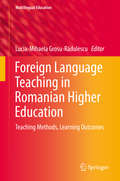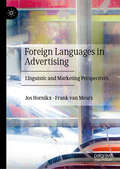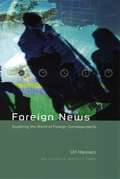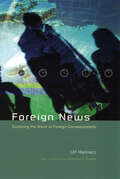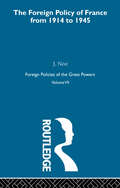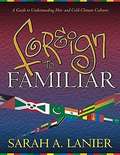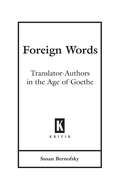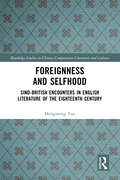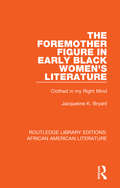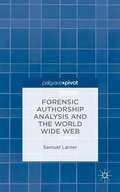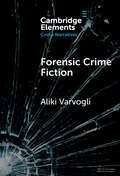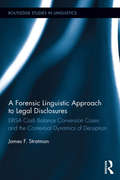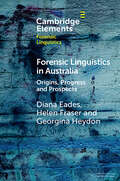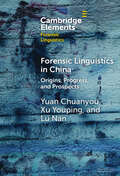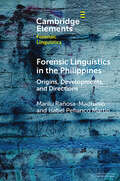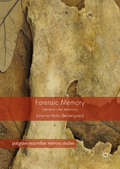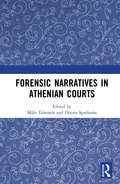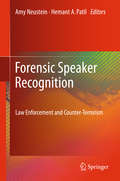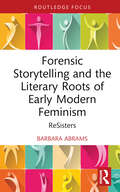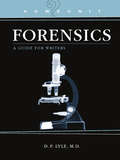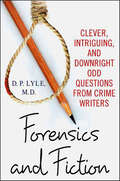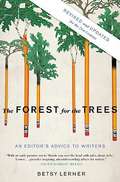- Table View
- List View
Foreign Language Proficiency in Higher Education (Educational Linguistics #37)
by Susan M. Gass Paula WinkeThis volume comprises of chapters that deal with language proficiency relating to a wide range of language program issues including curriculum, assessment, learners and instructors, and skill development. The chapters cover various aspects of a broad-based proficiency initiative, focusing on numerous aspects of foreign language learning, including how skills develop, how assessments can inform curriculum, how learners and instructors view proficiency and proficiency assessment, and how individual use of technology furthers language learning. The concluding chapter points the way forward for issues and questions that need to be addressed.
Foreign Language Teaching and the Environment: Theory, Curricula, Institutional Structures (Teaching Languages, Literatures, and Cultures #6)
by Charlotte Ann MelinAt a time when environmental humanities and sustainability studies are creating new opportunities for curricular innovation, this volume examines factors key to successful implementation of cross-curricular initiatives in language programs. Contributors discuss theoretical issues pertinent to combining sustainability studies with foreign languages, describe curricular models transferable to a range of instructional contexts, and introduce program structures supportive of teaching cultures and languages across the curriculum. Exploring the intersection of ecocritical theory, second language acquisition research, and disciplinary fields, these essays demonstrate ways in which progressive language departments are being reconceived as relevant and viable programs of cross-disciplinary studies. They provide an introduction to teaching sustainability and environmental humanities topics in language, literature, and culture courses as well as a wide range of resources for teachers and diverse stakeholders in areas related to foreign language education.
Foreign Language Teaching in Romanian Higher Education: Teaching Methods, Learning Outcomes (Multilingual Education #27)
by Lucia-Mihaela Grosu-RădulescuThis volume gathers recent research findings in the field of foreign language (FL) teaching in Romanian higher education dwelling on both methodology and students’ learning outcomes. The book satisfies the need for an up-to-date overview of FL teaching in Romanian universities in the European context as well as from a global international perspective. This book confers visibility to Romanian foreign language scholars’ research and it opens new paths for debate and collaboration worldwide. The scholars included in this volume have extensive expertise in the field of foreign language teaching and research in higher education which is supported by their international recognition as specialists in their specific areas.The contributing authors approach their respective chapters relying on both qualitative and quantitative research. Their experience and conclusions will prove helpful for any foreign language professional working in tertiary education.
Foreign Languages in Advertising: Linguistic and Marketing Perspectives
by Jos Hornikx Frank van MeursThis book presents a comprehensive account of the use and effects of foreign languages in advertising. Based on consumer culture positioning strategies in marketing, three language strategies are presented: foreign language display to express foreignness, English to highlight globalness, and local language to appeal to ethnicity (for instance, Spanish for Hispanics in the USA). The book takes a multidisciplinary approach, integrating insights from both marketing and linguistics, presenting both theoretical perspectives (e.g., Communication Accommodation Theory, Conceptual Feature Model, Country-of-origin effect, Markedness Model, Revised Hierarchical Model) and empirical evidence from content analyses and experimental studies. The authors demonstrate that three concepts are key to understanding foreign languages in advertising: language attitudes, language-product congruence, and comprehension. The book will appeal to students and researchers in the fields of sociolinguistics, applied linguistics, psycholinguistics, marketing and advertising.
Foreign Modernism
by Ihor JunykAt the beginning of the twentieth century, Paris was the cosmopolitan hub of Europe and home to a vast number of foreigners - including the writers, painters, sculptors, and musicians who were creating works now synonymous with modernism itself, such as Les Desmoiselles d'Avignon, The Rite of Spring, and Ulysses. The situation at the end of the period, however, could not have been more different: even before the violence of the Second World War, the cosmopolitan avant-garde had largely abandoned Paris, driven out by nationalism, xenophobia, and intolerance.Foreign Modernism investigates this tense and transitional moment for both modernism and European multiculturalism by looking at the role of foreigners in Paris's artistic scene. Examining works of literature, sculpture, ballet and performing arts, music, and architecture, Ihor Junyk combines cultural history with contemporary work in transnationalism and diaspora studies. Junyk emphasizes how émigré artists used radical new forms of art to resist the culture of virulent nationalism taking root in France, and to articulate new forms of cosmopolitan identity.
Foreign News: Exploring the World of Foreign Correspondents
by Ulf HannerzForeign News gives us a fascinating, behind-the-scenes look into the practices of the global tribe we call foreign correspondents. Exploring how they work, Ulf Hannerz also compares the ways correspondents and anthropologists report from one part of the world to another. Hannerz draws on extensive interviews with correspondents in cities as diverse as Jerusalem, Tokyo, and Johannesburg. He shows not only how different story lines evolve in different correspondent beats, but also how the correspondents' home country and personal interests influence the stories they write. Reporting can go well beyond coverage of a specific event, using the news instead to reveal deeper insights into a country or a people to link them to long-term trends or structures of global significance. Ultimately, Hannerz argues that both anthropologists and foreign correspondents can learn from each other in their efforts to educate a public about events and peoples far beyond our homelands. The result of nearly a decade's worth of work, Foreign News is a provocative study that will appeal to both general readers and those concerned with globalization.
Foreign News: Exploring the World of Foreign Correspondents (Lewis Henry Morgan Lecture Ser.)
by Ulf HannerzForeign News gives us a fascinating, behind-the-scenes look into the practices of the global tribe we call foreign correspondents. Exploring how they work, Ulf Hannerz also compares the ways correspondents and anthropologists report from one part of the world to another. Hannerz draws on extensive interviews with correspondents in cities as diverse as Jerusalem, Tokyo, and Johannesburg. He shows not only how different story lines evolve in different correspondent beats, but also how the correspondents' home country and personal interests influence the stories they write. Reporting can go well beyond coverage of a specific event, using the news instead to reveal deeper insights into a country or a people to link them to long-term trends or structures of global significance. Ultimately, Hannerz argues that both anthropologists and foreign correspondents can learn from each other in their efforts to educate a public about events and peoples far beyond our homelands. The result of nearly a decade's worth of work, Foreign News is a provocative study that will appeal to both general readers and those concerned with globalization.
Foreign Pol France 1914-45 V7
by NereFirst published in 2001. Routledge is an imprint of Taylor & Francis, an informa company.
Foreign to Familiar: A Guide to Understanding Hot- and Cold-Climate Cultures
by Sarah A. LanierThe book divides the world into two halves: hot-climate cultures and cold-climate cultures and intends to be helpful to those who wish to cross the culture gap.
Foreign Words: Translator-Authors in the Age of Goethe
by Susan BernofskyA new perspective on the principal developments in translation practice and theory in Germany during the Age of Goethe with emphasis on the work of Goethe, Hölderlin, and Kleist as translators.
Foreignness and Selfhood: Sino-British Encounters in English Literature of the Eighteenth Century (Routledge Studies in Chinese Comparative Literature and Culture)
by Mengmeng YanIn inviting a rethinking of ideas of foreignness and selfhood, this book explores Sino-British encounters in eighteenth-century English literature, providing detailed critical and literary analysis of individual texts pertaining to China from this period. The author provides a synthesis of approaches to China in eighteenth-century English literature, involving fictional writing related to China, adaptations of Chinese source texts, and translations of Chinese literary works. By discussing various writings about tea and tea-drinking, Arthur Murphy’s The Orphan of China (1759), Oliver Goldsmith’s The Citizen of the World (1760–62), and Thomas Percy’s Hau Kiou Choaan (1761), she highlights the significance of reading these texts not simply as documents of a historical kind, but as texts that are worthy of literary and artistic attention on the basis of their rich variety in genre, style, and themes. The author proposes that Chinese and British cultures are not antithetical entities: they exist in relation to one another and create possibilities in the continuing appreciation of diversity amidst a drive to universality. This study will be primarily helpful to university students and professors of English literature, comparative literature, and history worldwide.
The Foremother Figure in Early Black Women's Literature: Clothed in my Right Mind (Routledge Library Editions: African American Literature #1)
by Jacqueline K. BryantOriginally published in 1999 The Foremother Figure in Early Black Women's Literature looks at how stereotypical foremother figure exists in nineteenth century American literature. The book argues that older black woman portrayed in early black women’s works differs significantly from the older black women portrayed in early white women’s works. The foremother figure, then emerging in early black women’s fiction revises the stereotypical mother figure in early white women’s fiction. In the context of the mulatta heroine the foremother produces minimal language that, through an Afrocentric rhetoric, distinguishes her from the stereotypical mother and thus links her peripheral role and unusual behaviour to cultural continuity and radical uplift.
Forensic Authorship Analysis and the World Wide Web
by Samuel LarnerImplementing a novel method for identifying idiolectal co-selections and taking the UNABOM investigation as a case study, this book evaluates the effectiveness and reliability of using the web for forensic purposes, since forensic linguists often use the web as a tool in forensic authorship analysis cases. A notable example includes the American trial of the Unabomber, in which the web was searched for idiolectal co-selections, and claims made about their distinctiveness based on the number of search results. In order to assess whether the web can reliably be used in this way, two experiments are described in which the web is used to attribute documents to their authors, both when texts produced by candidate authors are, and are not, available for comparison. With considerable unreliability in the results- both between different search engines and over time - this book argues that more caution is required in using the web as a corpus for forensic purposes.
Forensic Crime Fiction (Elements in Crime Narratives)
by Aliki VarvogliThis study of forensic crime fiction from the US and the UK examines the prominent roles that women play in many of these novels, arguing that there are historical continuities with earlier forms of contact with the dead body. Refuting claims that the female forensic examiner exhibits traits of typically masculine behaviour, it suggests that the female gaze humanises the victims of crime and alters their representations. Utilising the views of a world-famous forensic scientist interviewed for this Element, this study also explores the role and treatment of science in forensic crime fiction, shedding light on an area of the genre. Finally, there is a consideration of killers in forensic crime novels, proposing that the relationship between killer and investigator is different from that of the classic crime novel. There are also two Appendices containing interviews with Professor Niamh Nic Daeid and with Val McDermid.
A Forensic Linguistic Approach to Legal Disclosures: ERISA Cash Balance Conversion Cases and the Contextual Dynamics of Deception (Routledge Studies in Linguistics)
by James StratmanThis book is a scholarly work of forensic linguistics that demonstrates how the principles of Gricean pragmatics and their recent elaboration in Information Manipulation Theory (IMT) can be of use to courts faced with deciding cases of allegedly fraudulent disclosure documents. The usual goal of legal rules for disclosure documents is not merely to prevent lying but other forms of deception as well. In particular, the goal of these rules is to force the communicator to reveal information that could cause material harm to certain receivers, harms that the communicator, for various reasons of self-interest, might prefer to keep secret or hidden. Because IMT and the Gricean framework have seldom been used in published studies to investigate legally mandated disclosure documents aimed at laypersons, this book seeks to enrich current explications of the rhetorical "workings" of deceptive disclosures within the broader Gricean tradition of pragmatics. The book questions the fundamental relationships among Grice’s maxims as well as the much circulated notion that violation of some maxims is more deceptive and more immoral than violations of others. In addition, the book also attempts to show how various other theories and research in discourse linguistics and reading comprehension can be used to support IMT analyses in addressing the discourse processing issues unique to legally required disclosure texts. In this way the book contributes to the larger dual mission of the field of forensic linguistics, which is both to understand and to improve courts’ impact on social justice.
Forensic Linguistics in Australia: Origins, Progress and Prospects (Elements in Forensic Linguistics)
by Diana Eades Helen Fraser Georgina HeydonThis Element presents an account of forensic linguistics in Australia since the first expert linguistic evidence in 1959, through early work in the 1970s-1980s, the defining of the discipline in the 1990s, and into the current era. It starts with a consideration of some widespread misconceptions about language that affect the field and some problematic ideologies in the law, which underly much of the discussion throughout the Element. The authors' report of forensic linguists' work is structured in terms of the linguistic, interactional and sociocultural contexts of the language data being analysed, whether in expert evidence, in research, or in practical applications of linguistics in a range of legal settings. The Element concludes by highlighting mutual engagement between forensic linguistic practitioners and both the judiciary and legal scholars, and outlines some of the key factors which support a critical forensic linguistics approach in much of the work in the authors' country.
Forensic Linguistics in China: Origins, Progress, and Prospects (Elements in Forensic Linguistics)
by Yuan Chuanyou Xu Youping Lu NanThis Element offers a comprehensive examination of forensic linguistics in China. It traces the origins of the field in the 1980s and 1990s, and highlights the progress made in the 2000s, with a focus on the work of influential scholars such as Pan Qingyun, Wang Jie, Du Jinbang, Liao Meizhen, Yuan Chuanyou, and Wang Zhenhua. It discusses the development of Discourse Information Theory, the Principle of Goal, Functional Forensic Discourse Analysis, and Legal Discourse as a Social Process. It also analyses studies on language evidence and explores legal translation. It discusses emerging research areas, including cyberbullying language research, internet court discourse analysis, authorship analysis, expert assistance systems, and speaker identification and evidence of forensic phonetics. This Element provides valuable insights into the growth and potential of forensic linguistics in China, serving as a comprehensive resource for scholars, researchers, and practitioners interested in the intersection of language and law.
Forensic Linguistics in the Philippines: Origins, Developments, and Directions (Elements in Forensic Linguistics)
by Marilu Rañosa-Madrunio Isabel Pefianco MartinThis Element offers a critical review of forensic linguistic studies in the Philippines. The studies within, collected over a period of eight to nine years, reveal relevant themes from texts in courtroom proceedings, legal writings, and police investigations. The studies also delve into issues of language choice and language policy. The Element begins with a description of language policy in the Philippines, focusing specifically on language in the legal domain. The main body of the Element is the critical review of Philippine forensic linguistics studies. This critical review takes a sociolinguistic stance, in that issues of language and law are discussed from the lens of social meanings and social practice. From this critical review of forensic linguistics studies, the authors hope to chart future directions for forensic linguistic studies and research in the Philippines.
Forensic Memory
by Johanne Helbo BøndergaardThis book describes and analyses a particular literary mode that challenges the aesthetics of testimony by approaching the past through detection, analysis, and ‘archaeological’ digging. How does forensic literature narrate the past in terms of plot, language, narration, and use of visual media? This volume examines how forensic literature provides an important corrective to the forensic paradigm and a means of exploring the relationship between visual and material evidence and various forms of testimony. This literary engagement with the past is investigated in order to challenge a forensic paradigm that aims to eliminate the problems related to human testimony through scientific objectivity, resulting in a fresh and original text in which Bøndergaard argues literature’s potential to explore the mechanisms of representation, interpretation, and narration.
Forensic Narratives in Athenian Courts
by Mike Edwards Dimos SpatharasForensic Narratives in Athenian Courts breaks new ground by exploring different aspects of forensic storytelling in Athenian legal speeches and the ways in which forensic narratives reflect normative concerns and legal issues. The chapters, written by distinguished experts in Athenian oratory and society, explore the importance of narratives for the arguments of relatively underdiscussed orators such as Isaeus and Apollodorus. They employ new methods to investigate issues such as speeches’ deceptiveness or the appraisals which constitute the emotion scripts that speakers put together. This volume not only addresses a gap in the field of Athenian oratory, but also encourages comparative approaches to forensic narratives and fiction, and fresh investigations of the implications of forensic storytelling for other literary genres. Forensic Narratives in Athenian Courts will be an invaluable resource to students and researchers of Athenian oratory and their legal system, as well as those working on Greek society and literature more broadly.
Forensic Speaker Recognition
by Hemant A. Patil Amy NeusteinForensic Speaker Recognition: Law Enforcement and Counter-Terrorism is an anthology of the research findings of 35 speaker recognition experts from around the world. The volume provides a multidimensional view of the complex science involved in determining whether a suspect's voice truly matches forensic speech samples, collected by law enforcement and counter-terrorism agencies, that are associated with the commission of a terrorist act or other crimes. While addressing such topics as the challenges of forensic case work, handling speech signal degradation, analyzing features of speaker recognition to optimize voice verification system performance, and designing voice applications that meet the practical needs of law enforcement and counter-terrorism agencies, this material all sounds a common theme: how the rigors of forensic utility are demanding new levels of excellence in all aspects of speaker recognition. The contributors are among the most eminent scientists in speech engineering and signal processing; and their work represents such diverse countries as Switzerland, Sweden, Italy, France, Japan, India and the United States. Forensic Speaker Recognition is a useful book for forensic speech scientists, speech signal processing experts, speech system developers, criminal prosecutors and counter-terrorism intelligence officers and agents.
Forensic Storytelling and the Literary Roots of Early Modern Feminism: ReSisters (Routledge Focus on Literature)
by Barbara AbramsThe writing of letters and the rise of the novel provided a way for some women to express themselves at a time when the all-male French Academy defined the very parameters of French literary acceptability and tradition. Women who were consigned to convents, workhouses or prisons were in most respects deprived of agency, yet many found ways to respond to the legal documents served against them. The letters and associated materials preserved in their legal files provide evidence that these women did not remain quiet, as they found means to resist authority. The forensic storytelling examined in this book supports the conclusion that the documents written in these constrained circumstances have both historical and literary merit and form the core of an understudied genre of literature.
Forensics: A Guide for Writers (Howdunit)
by D. P. LyleIn this world of crime-scene detection programs, mystery and thriller writers need to know at least the terminology of forensics to make their work realistic. Lyle, a cardiologist and mystery writer, provides the basic information that will keep writers from the most egregious errors. He covers the crime scene, blood stains, fingerprints, DNA and other popular themes. he also explains how one can tell if the deceased was manually strangled or hanged, how arson investigators work, the ways in which bodies decay and many other fine points of the study of murder. The book is written clearly with technical terms explained and simple drawings that educate without being gruesome. A bibliography, even of reputable websites, if not books and articles, would have been preferred to the advice that the reader search the Internet for keywords. Nevertheless, the book is a good starting point for writers or interested viewers and readers. Annotation ©2009 Book News, Inc. , Portland, OR (booknews. com)
Forensics and Fiction: Clever, Intriguing, and Downright Odd Questions from Crime Writers
by D. P. Lyle“Indispensable . . . Don’t even think of writing a medical mystery without the wise counsel of Dr. D. P. Lyle.” —Lee Goldberg, #1 New York Times–bestselling author of the Diagnosis Murder and Monk novelsHow long can someone survive in a cold, damp cave without food or water? How was diphtheria treated in 1886? Can Botox kill? Can DNA be found on a knife years later? How are mummified corpses identified? How long does it take blood to clot when spilled on a tile floor? What happens in death from electrocution?As a consultant to many novelists around the world and to the writers of such popular TV shows as Monk, Law & Order, House, and CSI: Miami, D. P. Lyle, M.D., has answered many cool, clever, and oddball questions over the years. Forensics and Fiction: Clever, Intriguing, and Downright Odd Questions from Crime Writers is a collection of the best of these questions. The answers are provided in a concise and entertaining fashion that will keep you wide awake so you can read “just one more.”“A terrific resource for crime writers and anyone interested in forensics . . . will jump-start your imagination about all kinds of ingenious crimes, crime-solving techniques, and plot twists.” —Matt Witten, supervising producer of the Fox TV show House
The Forest for the Trees (Revised and Updated)
by Betsy LernerQuickly established as an essential and enduring companion for aspiring writers when it was first published, Betsy Lerner's sharp, funny, and insightful guide has been meticulously updated and revised to address the dramatic changes that have reshaped the publishing industry in the decade since. From blank page to first glowing (or gutting) review, Betsy Lerner is a knowing and sympathetic coach who helps writers discover how they can be more productive in the creative process and how they can better their odds of not only getting published, but getting published well. This is an essential trove of advice for writers and an indispensable user's manual to both the inner life of the writer and the increasingly anxious place where art and commerce meet: the boardrooms and cubicles of the publishing house.


